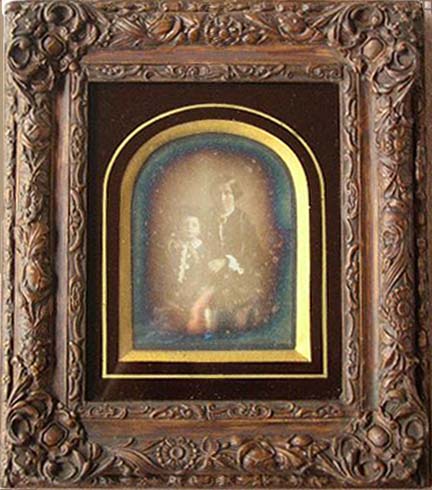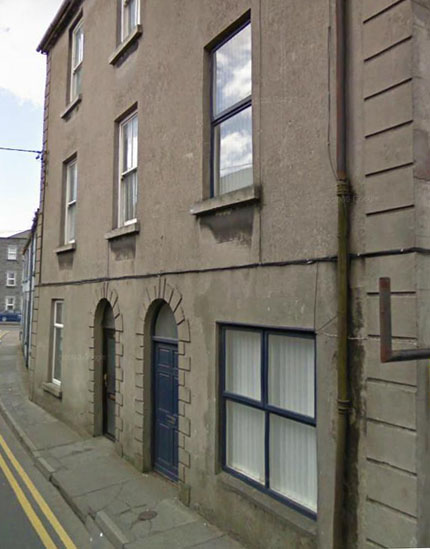Richard Beauford in Wales
After he had disposed of his
Hastings studio to White & Connop, Richard Beauford (real
name Richard Brothers Finlayson) embarked on a career as a
travelling photographer. By August 1853, Richard Beauford had set up a
temporary studio at Newcastle-under-Lyme, near the Literary and
Scientific Institute in Brunswick Street. Richard Beauford remained at
Newcastle-under-Lyme for a few months and then moved on from
Staffordshire to Shropshire. From May to October 1854, Richard Beauford
was based in Castle Street in the town of Shrewsbury. In
November, the studio in Castle Street, Shrewsbury was passed to Henry Beauford, a daguerreotype artist who had previously worked on the Isle
of Wight. It seems likely that the photographic artist Henry Beauford
was the brother of Richard Beauford (real name Richard
Brothers Finlayson) and that Henry Finlayson had also adopted the
surname of "Beauford". In September, 1854, Richard Beauford
visited Aberystwyth with his daguerreotype apparatus and took
portraits at No 15 Terrace Road. In October 1854, Richard Beauford set
off on an extended tour of Wales and the Welsh borders. Travelling with
a portable studio, Richard Beauford visited Hereford, Ross-on-Wye,
Monmouth, Abergavenny, Brecon, Carmarthen,
Tenby,
Newport and Pontypool.
Richard Beauford arrived in Newport,
Monmouthshire in October 1855 and opened what he described as "The
Monmouthshire Photographic Gallery" at the Old Canal Office,
High
Street, near Newport Bridge, on Monday 22nd October 1855. Publicity
flyers informed the inhabitants of Newport that Beauford would
be taking portraits at his 'Photographic Gallery' for "ONE FORTNIGHT
ONLY". Although Beard's Daguerreotype Patent had expired in August
1853 and Frederick Scott Archer's Collodion Process was being
widely used in 1855, Beauford was still producing coloured daguerreotype
portraits with the aid of his registered "Accelerator". Richard Beauford
favoured the daguerreotype over the collodion positive portrait
for both artistic and practical reasons. In a publicity sheet issued in
October 1855, Beauford quotes a favourable review of his work which
states that "by means of his registered invention, the 'Daguerreotype
Accelerator', he is enabled to take likenesses on the
dullest day, which surpass, in clearness and exquisite delineation,
anything we have ever seen". The review went on to compare
Beauford's daguerreotype portraits on 'silver plate' by "contrasting
them with recently taken Collodion portraits". The reviewer
was struck by the differences between Beauford's daguerreotypes
and the collodion positive portraits on glass : "The
difference in an artistic point of view, was found to be astonishingly
in favour of the former (Beauford's daguerreotypes) and this
superiority was the more strongly felt when it was observed that, even
in pictures only a few weeks old, the tendency of Collodion to separate
from the glass plate had shown itself, to the great detriment of the
picture".
In 1855, Richard Beauford's daguerreotype
portraits started at 5s 6d - a sum which would pay for a small
portrait in a frame. Daguerreotype portraits in a "handsome Morocco
case" ranged in price from 7s 6d to 25 shillings, depending on the
size of the photographic plate.
By December 1855, Richard Beauford had reached
Pontypool, where he set up a temporary studio at the King's Head
Inn. Pontypool appears to have been the last stop in his extended tour
of Wales. Richard Beauford's name does not appear as a photographic
artist in England or Wales in trade directories published after 1855 and
evidence suggests that he ended his photographic career in Ireland.
Richard Beauford in Ireland
In 1853, Richard Beauford had shown his
Registered Daguerreotype Accelerator together with samples of his lenses
and examples of his photographic work at exhibitions in Dublin. The
catalogue of the International Exhibition held in Dublin in 1853 lists
Exhibit No 653 as "Lenses with accelerators" and "Photographs" by
'Robert Beaufort'. It is clear from Beauford's own publicity about
showing his work in Dublin, that the name of 'Robert Beaufort' was a
printing error and that Richard Beauford was the exhibitor. A detailed
catalogue of the contents of The Irish Industrial Exhibition of 1853
mentions "the lenses and accelerators of Mr R. Beaufort (sic)"
as one of "several exhibitors of cameras and other apparatus connected
with photography". It appears that some time in the 1850s, Richard Beauford returned to Ireland and
set up a photographic studio in Sackville Street, Dublin. In the 1860s,
it is possible that he entered into a partnership with a photographer named Bruce.
In 1865, Beauford & Bruce had a studio in Kilkenny, Ireland. It
is recorded that the partnership of Beauford & Bruce exhibited some
"Photographic views of Ireland" at the International Exhibition held in
Dublin in 1865.
Steve Dolan
of the South East Galway Archaeological and Historical Society
has found evidence that by the end of the 1860s, the partnership of
Beauford & Bruce were based at 2 Nun's Island, Galway.
Steve Dolan has discovered that Beauford & Bruce
photographed a cricket match in Galway in 1869; the event being
mentioned in a newspaper article published in the Galway
Vindicator on 17th July 1869. Steve
Dolan reports that the photographers Beauford & Bruce
showed their work at both the Philadelphia and Paris
Exhibitions in 1876 and 1877.[ When Freeman's Journal
reported on the Galway firm's participation in these international
exhibitions they referred to the partnership as "Beaufort & Bruce"].
The firm of Beauford & Bruce are last mentioned working
from their studio at Nun's Island, Galway in the year 1878. By this time,
Richard Beauford would have been in his early sixties.
Richard Brothers Finlayson, who for
37 years operated under the assumed name of "Richard Beauford",
died in Galway, Ireland, on the 17th December 1886. His
age at death was recorded as 75, but other sources (such as the 1851
census) suggests that he might have been in his early 70s at the time of
his demise. |
|
 |
|
[ABOVE] A
daguerreotypes portrait of a woman and child produced by Richard
Beauford at Newport,
Wales in October 1855. |
|
PHOTO: Courtesy of Alan Cook of Woodstone
Antiques and Ruby Lane Inc. |
|

|
|
[ABOVE] A
modern photograph of the buildings at Nun's Island, Galway,
showing the site of Beauford & Bruce's photographic studio at No.
2 Nun's Island. |
|
PHOTO : Courtesy of
Steve Dolan of South East Galway Archaeological and
Historical Society |
|




















